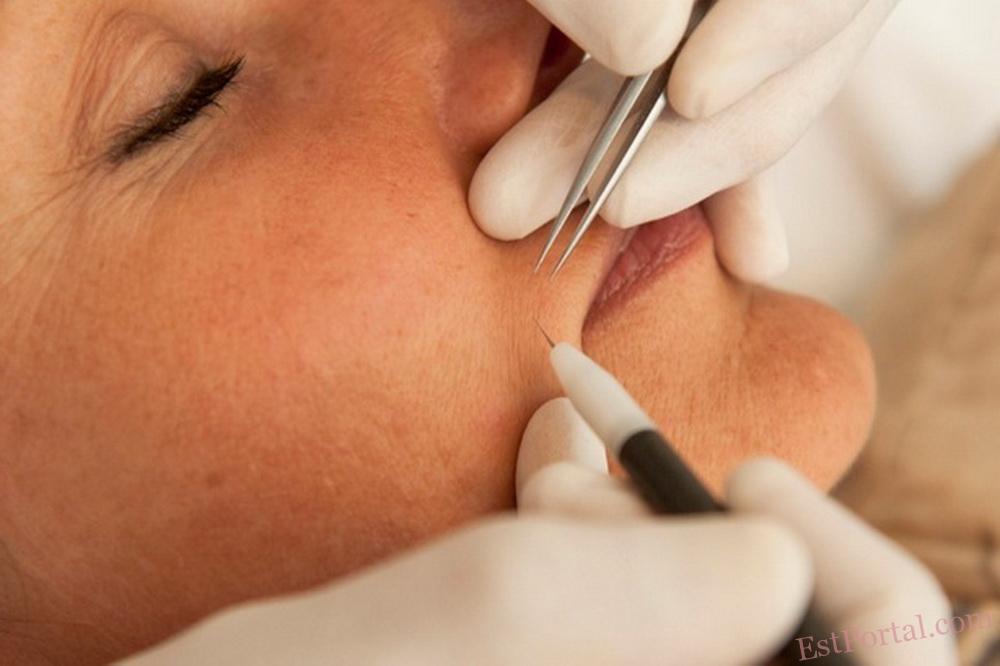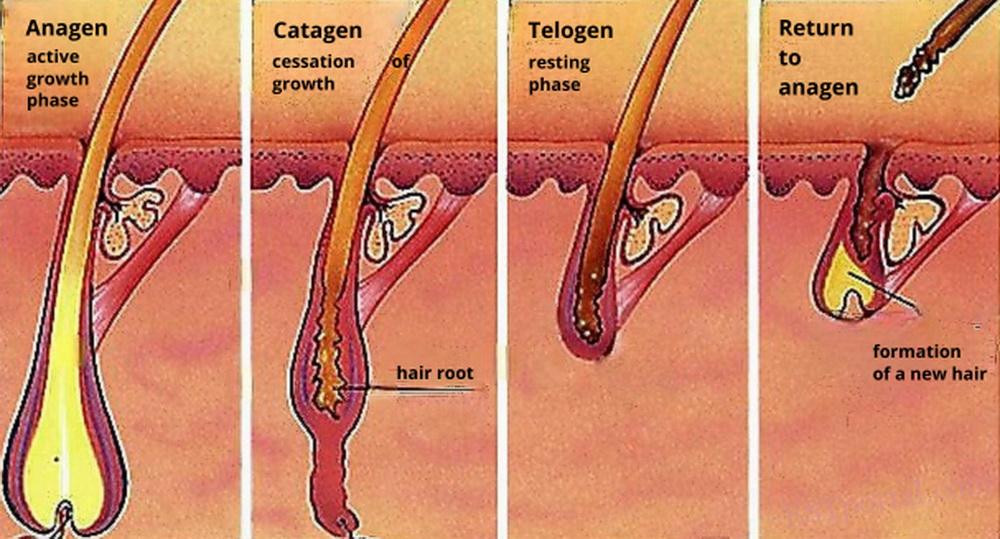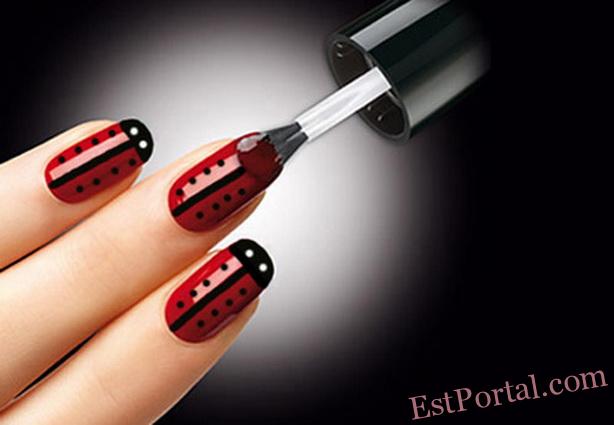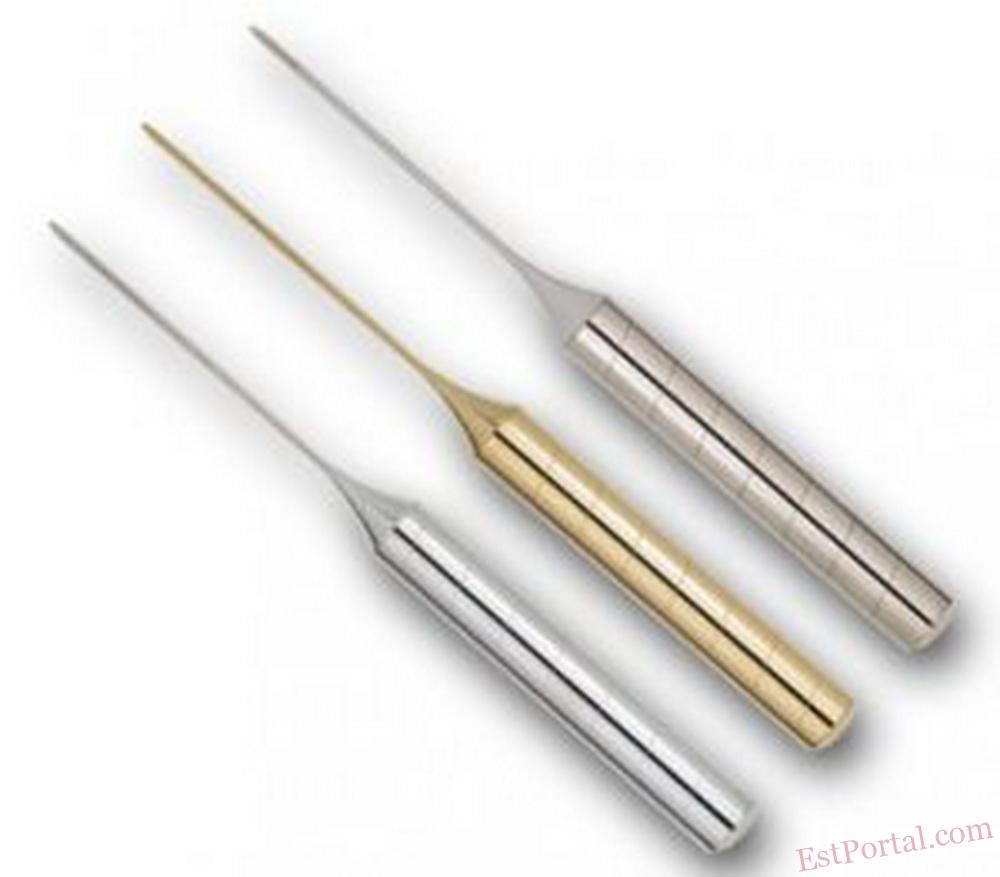
Electrolysis Hair Removal
Electrolysis is a method of radical hair removal and prevention of new hair growth through the controlled application of electric current to the hair follicles. During electrolysis, the current, delivered via an electrode, penetrates to the depth of the hair bulb and causes its thermal destruction. Electrolysis is effective for all hair types (including fine, gray, light, and hormone-dependent hairs) and for any skin phototype. It is often performed as a complement to laser hair removal to eliminate residual hairs.
Electrolysis is the chronologically earliest hardware method of hair removal, used in Europe since the 1940s. The mechanism of electrolysis is based on the destructive effect of electric current on the germinative part of the hair follicle. The electric current is delivered by precisely inserting a fine electrode into each individual follicle. The generated electric impulse produces a micro-spark at the tip of the electrode, causing a localized high-temperature heating of the germinative zone of the hair bulb and its complete destruction.
After electrolysis, hair growth from the destroyed follicles stops permanently. Electrolysis can be used to remove hair on the eyebrow line, cheeks, upper and lower lip, chin, neck, shoulders, back, chest, breasts, arms, abdomen, legs, bikini area, and fingers and toes. Performing electrolysis in the armpit area is not recommended due to the high concentration of lymph nodes in this region. Electrolysis is not performed in the ear auricles or nasal passages. The most painful areas for electrolysis are the upper lip and bikini zone.
Electrolysis is the only method that can permanently remove unwanted hair. However, achieving this effect in just one session is impossible. Since hair has three growth stages, the procedure affects only those hairs that are currently in the active growth phase or have already fully developed. Thus, after the first session, about two weeks later, a new batch of hair appears — those that were in the resting phase during the previous treatment. The hairs removed during the first session may regrow, but they will be weaker, thinner, and less visible. At the same time, some hairs may be permanently destroyed even after the first session.
In any case, the number of sessions required for complete hair removal depends solely on individual physiological characteristics. Some people may need six sessions, while others may require twelve. Noticeable results from electrolysis appear after the first three sessions (on the same area of skin). To achieve complete and lasting results, one should be patient for about a year to a year and a half. As soon as new hairs appear in the treated area, you should return to your electrologist — and under no circumstances use any other hair removal methods, otherwise all previous efforts may be in vain.
Before the procedure, it is recommended to test your body’s reaction to electrolysis on a small area of skin. Observe how quickly the irritation at the treated site subsides and how many days it takes for the needle marks to disappear. Check for any individual intolerance to this type of electrolysis. Once the test treatment on a small patch of skin is successful, you can confidently proceed with the full procedure! In any case, after 3–4 sessions the effect will be noticeable — there will be significantly less hair, and those that continue to grow will become thinner, weaker, and will eventually disappear permanently.
Classification of Electrolysis Methods
Depending on the type of electrodes used, electrolysis methods are divided into tweezer and needle types.
The tweezer electrolysis method involves grasping each hair to be removed with a fine tweezer electrode connected to a high-frequency current generator. The electric current travels along the shaft of the hair held by the tweezers, penetrating the follicle and causing its destruction. Tweezer electrolysis is non-invasive, the least painful, and ideal for treating sensitive areas of the body (such as the face and bikini zone). However, due to its slow speed (each individual hair may require up to 1.5–2 minutes of treatment), this method is unsuitable for removing hair from large skin areas.
Varieties of needle electrolysis, depending on the characteristics of the current used and their combinations, include thermolysis, electrolysis, blend, and flash methods, as well as their modifications. The prefixes “new,” “super,” and “ultra” indicate different variations of the basic electrolysis techniques without any fundamental differences. Needle electrolysis is classified as an invasive method of hair removal, as it involves inserting a fine conductive needle into the skin through which the current of specific parameters is delivered.
Thermolysis, as a method of electrolysis, involves the destruction of the hair follicle using an alternating high-frequency current of low voltage. The delivery of electric impulses causes an instant high-temperature reaction and coagulation of the follicles that are in the active growth phase. Thermolysis is often used in electrolysis practice, although its performance carries certain risks and requires high professional skill and experience. This type of electrolysis is the most painful and often requires not only topical anesthetics but also injectable anesthesia (such as lidocaine, trimecaine, etc.). However, the use of injectable anesthetics may alter the electrical parameters, making the procedure less effective. In some cases, an increase in localized hair growth has also been observed.
The advantage of thermolysis is the relatively high speed of hair removal — about 22 hairs per minute — which makes it convenient for treating large skin areas. The disadvantages of this electrolysis method include significant pain, the risk of folliculitis and multiple atrophic scars, as well as the difficulty of reaching the lower segments of curved follicular canals.
Electrolysis is based on an electrochemical reaction that occurs under the influence of direct (galvanic) current. During the electrolysis hair removal process, the direct current causes the formation of sodium ions around the needle electrode, which, when interacting with tissue fluid, turn into microdoses of alkali. The alkaline substance penetrates into parts of the hair bulb unreachable by the electrode and destroys them. Using the electrolysis method, curved hair follicles can be effectively treated. During the procedure, the passive electrode is placed in the client’s hand, while the active electrode (needle) is inserted along the hair shaft to the depth of the follicle. Then, the current is applied, and its intensity is adjusted on the device according to standard recommendations, depending on the hair thickness and follicle depth. The appearance of small bubbles of foam — released hydrogen — around the treated hair indicates that the electrochemical reaction is complete. The hair is then removed with tweezers. Electrolysis is a less painful method of electroepilation than thermolysis, but it is slower — averaging about 4 hairs per minute. Even with multi-needle electrolysis systems, the process requires considerable time to treat large areas of the body.
Blend electrolysis (from blend — combination) combines the effects of high-frequency alternating current and direct galvanic current — that is, thermolysis and electrolysis. The blend method not only produces alkali but also heats it, enhancing its destructive effect on the follicles. As a result, the duration of the electrolysis procedure is reduced, while its efficiency increases.
In the process of blend electrolysis, two stages of follicle exposure are distinguished. The first phase — thermolytic — is characterized by heating of the follicle and dehydration of the perifocal (surrounding) tissues. During the second, electrolytic phase, a galvanic reaction occurs with the formation of a small amount of alkaline environment, sufficient for the final destruction of the follicle. Modern blend epilators feature a built-in computer module that optimally adjusts the thermo- and electrolytic phases according to the individual characteristics of the patient. The limitations of the blend method include its relatively low speed and the risk of folliculitis and scarring.
A modification of the blend electrolysis method is the sequential blend. This technique differs from the traditional blend method by reducing the amplitude of the galvanic current during the pulse, which enhances the destructive effect on the follicle while reducing discomfort.
Flash electrolysis (flash — “spark” or “flash”) is an advanced form of thermolysis that uses a continuous current of very high frequency (2000 kHz). The exposure time during flash electrolysis is extremely short — from 0.01 to 0.09 seconds. Electrolysis needles are equipped with mandatory insulation, which virtually eliminates pain and tissue trauma. The flash method is not recommended for electrolysis of the bikini area and face but is highly effective for treating hair on the arms and legs.
An improved version of the flash method is the sequential flash, which employs a high-frequency sinusoidal alternating current that allows the electrologist to adjust parameters depending on the hair quality within the same area. Sequential flash also enables variation in pulse duration based on hair thickness: the thicker the hair, the shorter the pulse and the stronger the current.
Electrolysis needles come in three types: insulated, gold, and medical alloy.
- Insulated needles are coated with a microscopically thin insulating layer (usually Teflon) less than 1 micron thick, protecting the surrounding tissue from burns; they are recommended for clients with increased pain sensitivity.
- Needles made from a medical-grade chrome-nickel alloy — the same material used for fine surgical instruments — are suitable for patients who tolerate electrolysis well.
- Gold electrolysis needles are coated with 24-karat gold and contain no nickel; they are ideal for clients whose skin is sensitive to metal alloys.
Contraindications for electrolysis:
- presence of a pacemaker;
- pregnancy;
- exacerbation of chronic skin diseases;
- acute infectious or purulent skin conditions;
- epilepsy;
- presence of nevi or moles in the treatment area;
- individual intolerance to electric current;
- diabetes mellitus;
- varicose veins (at the treatment site);
- severe forms of hypertension and coronary heart disease;
- oncological diseases;
- certain gynecological disorders (when performing electrolysis in the bikini area).
Advantages and disadvantages of electrolysis
The advantages of electrolysis include its affordability, radical effectiveness, and the ability to remove hair of any color and on any skin phototype.
Potential risks of electrolysis include the possibility of infection due to skin damage by needles, as well as the development of folliculitis, scarring, and hyperpigmentation.
The outcome of electrolysis depends on the specialist’s qualification, the quality of the equipment used, the adequacy of anesthesia, the regularity of sessions, and the correctness of post-treatment care.
Nataliya CHAYKA – Editor of ESTportal, Aesthetic Doctor











